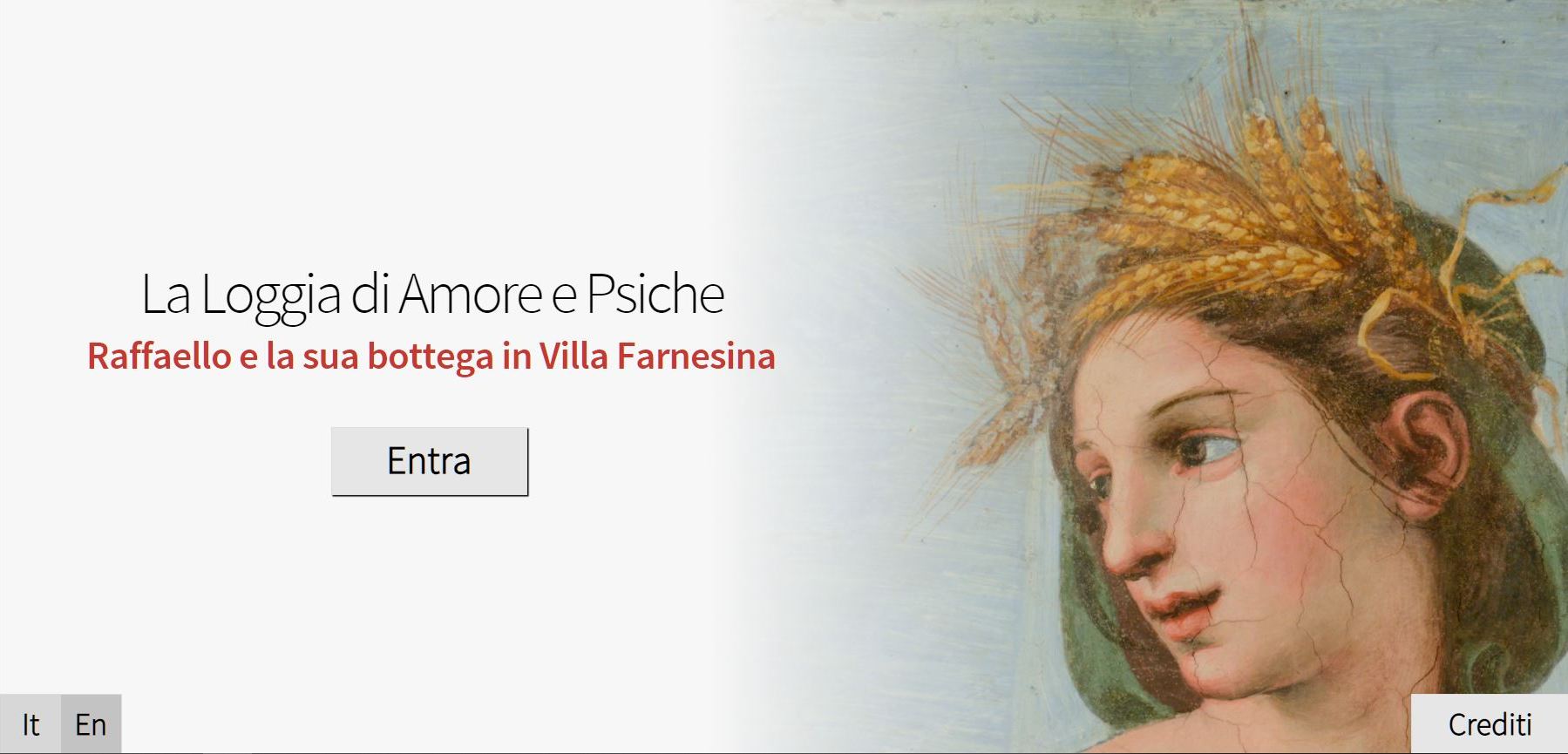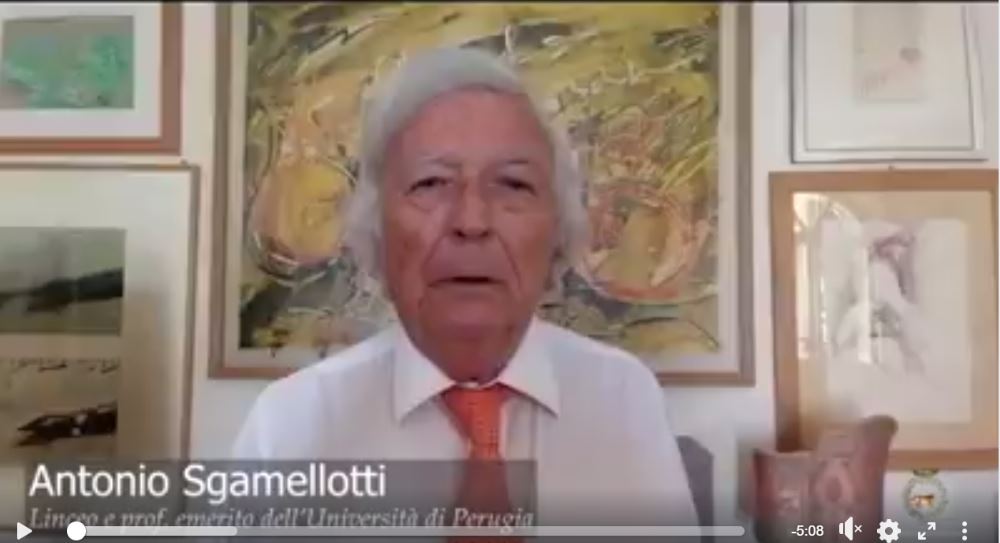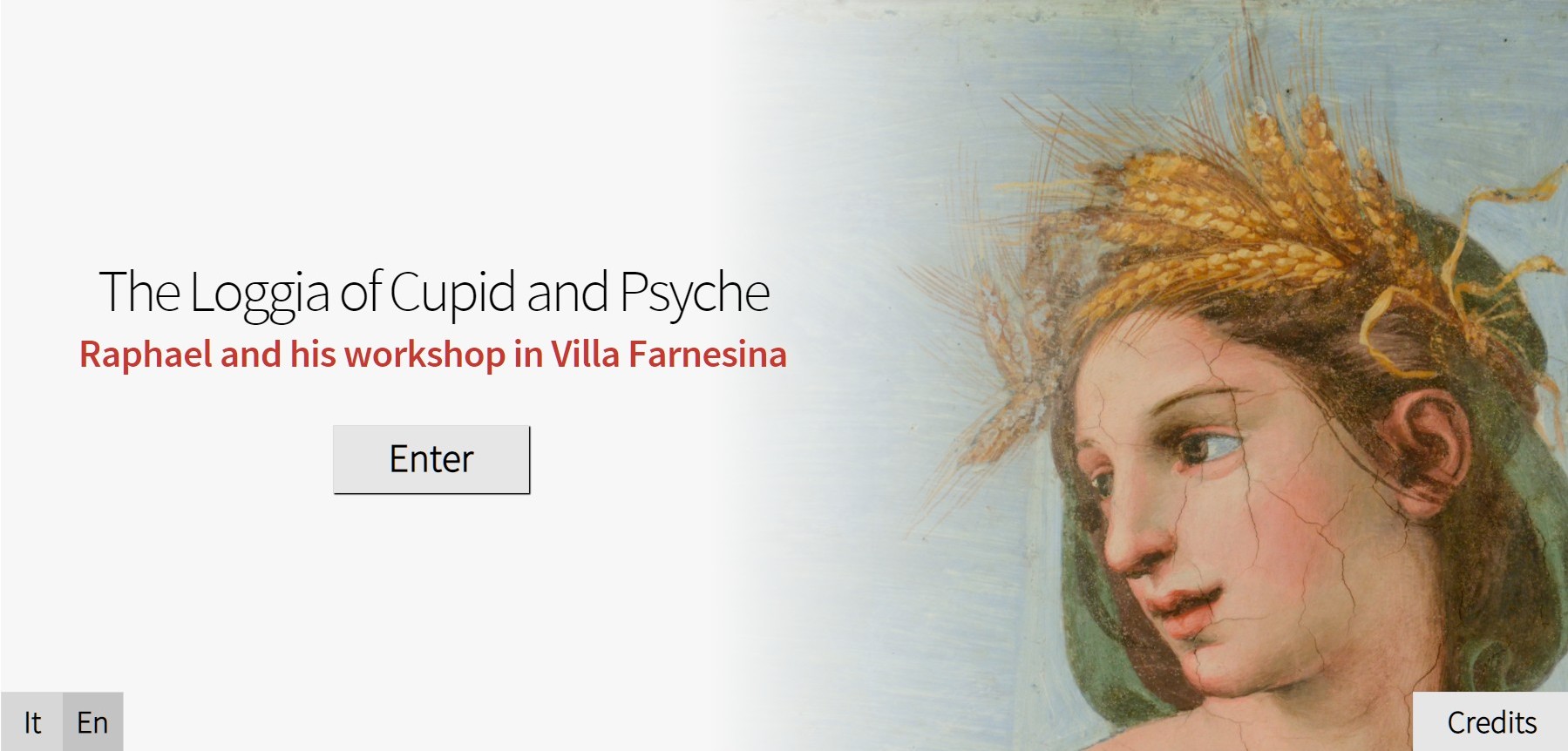

Il progetto 'Una Loggia digitale per Raffaello'
Al link http://vcg.isti.cnr.it/farnesina/loggia/ è accessibile il sistema interattivo che consente di osservare a una distanza ravvicinata le storie di Amore e Psiche per godere, con un dettaglio mai visto, i particolari della Favola di Apuleio, delle specie vegetali e delle figure di animali dipinti da Raffaello e dai suoi collaboratori nella volta della Loggia di Amore e Psiche in Villa Farnesina, Roma.
Il sistema digitale è stato progetato e sviluppato dal Visual Computing Lab dell'ISTI-CNR sulla base di un importante progetto scientifico di studio e conservazione della Loggia per conto dell'Accademia Nazionale dei Lincei al fine di esplorare il soffitto affrescato della Loggia di Amore e Psiche di Raffaello e allievi in Villa Farnesina ai tempi del COVID-19.
Il progetto e la pandemia
Il sistema digitale interattivo, concepito inizialmente come programmazione “ordinaria” nell’ambito delle celebrazioni per il V centenario della morte di Raffaello Sanzio (6 aprile 1520), è stato ripensato e promosso su Web dall’Accademia Nazionale dei Lincei in sinergia col Consiglio Nazionale delle Ricerche, durante l’emergenza sanitaria globale COVID-19 in attesa di tornare a vedere dal vivo la magnificenza di Villa Farnesina e le mostre dedicate al grande artista nella Villa.
La pandemia, infatti, ha costretto Villa Farnesina a riorganizzare il calendario degli eventi e, allo stesso tempo, ad implementare il proprio apparato digitale per promuovere la conoscenza del proprio patrimonio anche al di fuori dei suoi visitatori.
La Loggia digitale e le mostre su Raffaello
Il sistema interattivo dedicato fornisce anche un supporto pratico alle due mostre programmate per celebrare il "divin" pittore: la mostra "Raffaello in Villa Farnesina: Galatea e Psiche" (6 ottobre 2020 - 6 gennaio 2021) e la mostra "Raffaello e l’Antico nella Villa di Agostino Chigi" posticipata a data da definire.Lo scopo della Loggia digitale
La Favola di Amore e Psiche, i festoni vegetali e gli animali, progettati da Raffaello e dipinti dai suoi maggiori allievi (Giulio Romano e Giovanni da Udine) intorno al 1518 per l'omonima Loggia nella residenza del banchiere senese Agostino Chigi sul lato suburbano del Tevere, costituiscono un documento unico per la concezione dell'opera da parte di Raffaello e la straordinaria biodiversità botanica e zoologica che convergeva a Roma da tutto il mondo. In particolare, la Favola è la prima rappresentazione pittorica tratta dalle "Metamorfosi" di Apuleio e sarà poi ripresa da molti artisti postumi; i festoni erano un potente strumento di meraviglia, un evidente simbolo di prosperità e hanno il primato di essere la prima documentazione delle piante appena arrivate in Europa dopo la scoperta dell'America, mentre gli animali mostrano la fauna presente al tempo nelle campagne romane e non solo.
L'obiettivo del progetto è dunque consistito nella realizzazione di un sistema digitale interattivo e intuitivo dell'opera di Raffaello e della sua bottega che permette di accedere ai ricchi contenuti frutto di un’intensa attività di ricerca multidisciplinare.
Pertanto la Loggia Digitale (IT/EN) è organizzata in 7 sezioni: “La Loggia”, “La Favola”, “I Festoni”, “Gli Animali”, “I Colori” e “R. Calcografia” permettono di consultare i contenuti culturali arricchiti da immagini storiche e i risultati delle indagini scientifiche, mentre la sezione “Esplora” accoglie i 3 sistemi di navigazione e consultazione interattiva della Loggia di Amore e Psiche.
Il sistema è stato realizzato in maniera innovativa in modo da poter gestire con facilità un rilievo ad altissima definizione ed è stato pensato per un pubblico generico ormai pratico di sistemi di fruizione virtuale basati su immagini panoramiche come, ad esempio, i vari visualizzatori di contesti urbani quali Google Street View. Pertanto esso è facilmente accessibile, limita il più possibile i tempi di caricamento delle informazioni e offre strumenti intuitivi di orientamento in tutta la navigazione. Il sistema è stato realizzato su due livelli di dettaglio per consentire in tutte le schede di approfondimento di apprezzare i particolari ad un livello di risoluzione ancora più alto rispetto a quello della panoramica dell’intera volta.
Approfondimenti esterni principali
- TG3 (17’:35”)
- RAI CULTURA
- ARTE SKY
- Finestre sull’Arte
- ARTE MAGAZINE
- ARTRIBUNE
- CORRIERE DELLA SERA
- CORRIERE NAZIONALE
- IL MANIFESTO
- IL GIORNALE D'ITALIA
- LA REPUBBLICA Roma
- LA NAZIONE Pisa
- THE WORLD NEWS > ITALIAN NEWS PLATFORM
- AISE.it
- Anuario TAREA 7
- WEBINAR – The Cyprus Institute, June 30 2020 (live)
- WEBINAR – Italian Cultural Institutes of the United States and Canada
Riferimenti bibligrafici
- Gianpaolo Palma, Eliana Siotto, Una Loggia digitale al tempo del COVID-19 in A. Sgamellotti, V. Lapenta, C. Anselmi, C. Seccaroni (a cura di) Raffaello in Villa Farnesina: Galatea e Psiche, Bardi Ed., Roma 2020, pp. 89-96 (ISBN 978-88-948-1052-3).
'A digital Loggia for Raphael' project
At http://vcg.isti.cnr.it/farnesina/loggia/, you can observe at a close distance both the beautiful stories of Cupid and Psyche to enjoy, with unprecedented detail, the Fable of Apuleius, the vegetal and animals painted by Raphael and his assistants in the Loggia of Cupid and Psyche in Villa Farnesina, Rome.
The digital system was designed and developed by the Visual Computing Lab of ISTI-CNR based on a critical scientific study and conservation project of the Loggia on behalf of the Accademia Nazionale dei Lincei to explore the fantastic frescoed ceiling in Villa Farnesina in the time of COVID-19.
The project and the pandemic
The interactive digital system initially conceived as "ordinary" programming as part of the celebrations for the fifth centenary of the death of Raffaello Sanzio (April 6 1520), has been rethought and promoted on the Web by the Accademia Nazionale dei Lincei in synergy with the National Council of Research, during the global health emergency COVID-19 waiting to return to see live the magnificence of Villa Farnesina and the exhibitions dedicated to the great artist in the Villa.
The pandemic forced Villa Farnesina to reorganize the calendar of events and, at the same time, to implement its digital apparatus to promote knowledge of its heritage even outside its visitors.
The access numbers to the "Digital Loggia" and the numerous feedback received from scholars and traditional institutions, national and international, confirm the high level of appreciation found by the system, quoted in the well-known Italian magazine Il Giornale dell'Arte of May-June 2020 among the "136 reopenings of projects in Italy and around the world". The digital Lodge seems to represent a virtuous communication model of the artwork and its contents on the Web.
During the months of lockdown, the system found a great media promotion on the leading specialized newspapers, national and local media, social networks and the web (TG3 (17 ': 35 "), Rai Cultura, Arte Sky, Finestre sull'Arte, Magazine, Corriere della Sera, Repubblica Roma, La Nazione di Pisa, Webinar, etc.) with stimulating effects on cultural use.
The digital Loggia and the exhibitions on Raphael
The dedicated interactive system provides practical support to the two exhibitions planned to celebrate the divine painter: the "Raphael in Villa Farnesina: Galatea and Psyche" exhibition (October 6 2020 - January 6 2021) and the "Raphael and the Ancient in the Villa by Agostino Chigi" exhibition postponed to a date to be defined.
The purpose of the digital Loggia
The Fable of Cupid and Psyche, the animals and the vegetable festoons, were designed by Raphael and painted by his principal assistants (Giulio Romano and Giovanni da Udine), around 1518, for the homonymous Loggia in the residence of the Sienese banker Agostino Chigi on the suburban side of the Tiber. The frescoes constitute a unique document for Raphael's conception of the work and the extraordinary botanical and zoological biodiversity that converged in Rome from all over the world. In particular, the Fable is the first pictorial representation taken from Apuleius's "Metamorphoses" and will then be taken up by many posthumous artists. The festoons were a powerful tool of wonder, an evident symbol of prosperity. They had the distinction of being the first documentation of the plants just arrived in Europe after America's discovery. Simultaneously, the animals show the fauna present at the time in the Roman and non-Roman countryside only.
Therefore, the project's objective consisted in the creation of an interactive and intuitive digital system of Raphael's work and his workshop that allows access to the rich contents resulting from intense multidisciplinary research. Therefore the Digital Loggia (IT/EN) is organized in 7 sections: "Loggia", "Fable", "Festoons", "Animals", "Colors" and "R. Chalcography" allow consulting the cultural contents enriched by historical images and the results of scientific investigations, while the" Explore" section houses the 3 navigation and interactive consultation systems of the Loggia of Cupid and Psyche.
The system has been designed innovatively to be able to manage a very high definition survey easily. It has been designed for a general public now familiar with virtual fruition systems based on panoramic images such as, for example, the various viewers of urban contexts. Such as Google Street View. Therefore, it is easily accessible, limits the loading times of information as much as possible and offers intuitive orientation tools throughout the navigation. The system was created on two levels of detail where the in-depth sheets allow the user to appreciate the elements at an even higher level of resolution than that of the whole vault overview.
Main external reading
- TG3 (17’:35”)
- RAI CULTURA
- ARTE SKY
- Finestre sull’Arte
- ARTE MAGAZINE
- ARTRIBUNE
- CORRIERE DELLA SERA
- CORRIERE NAZIONALE
- IL MANIFESTO
- IL GIORNALE D'ITALIA
- LA REPUBBLICA Roma
- LA NAZIONE Pisa
- THE WORLD NEWS > ITALIAN NEWS PLATFORM
- AISE.it
- Anuario TAREA 7
- WEBINAR – The Cyprus Institute, June 30 2020 (live)
- WEBINAR – Italian Cultural Institutes of the United States and Canada
References
- Gianpaolo Palma, Eliana Siotto, A digital Loggia at the time of COVID-19 in A. Sgamellotti, V. Lapenta, C. Anselmi, C. Seccaroni (eds.) Raphael in Villa Farnesina: Galatea and Psyche, Bardi Ed., Rome 2020, pp. 91-98 (ISBN 978-88-948-1057-8).
IN EVIDENZA
CINA - La “Loggia Digitale di Raffaello in Villa Farnesina” esposta a partire da dicembre 2020 grazie alla collaborazione con l'Associazione PromoItalia aderente alla rete Cerealia Festival e con sede in Shanghai e Napoli.
Video in inglese con sottotitoli in cinese ed inglese che puoi impostare nelle tue preferenze.
Locandina degli eventi e delle istituzioni che ospitano la Loggia Digitale in Cina.
CREDITI
Curatori e sviluppatori del sistema digitale per ISTI-CNR: Gianpaolo Palma ed Eliana Siotto
Altri partner del progetto:
- Accademia Nazionale dei Lincei
- Università Roma Tre CROMA-Dip. Scienze
- Università degli Studi della Tuscia DIBAF
- XGLab® Srl
- ENEA-SSPT
- Centro SMAArt Università di Perugia
- Laboratorio Diagnostica Beni Culturali Spoleto
Questa attività è stata realizzata nell'ambito dell'Accordo Programma Quadro tra il Consiglio Nazionale delle Ricerche italiano e l'Accademia Nazionale dei Lincei, stipulato il 12 luglio 2012 (CNR N. 535-BIS / 12. REP. ON CNR N. 2584 | 112).
Si ringrazia Roberto Scopigno, Direttore dell'ISTI-CNR di Pisa.
CONTATTI
- Gianpaolo Palma - gianpaolo.palma@isti.cnr.it
- Eliana Siotto - eliana.siotto@isti.cnr.it
phone +39 050 315 2940
HIGHLIGHTS
CHINA - The "Digital Loggia of Raffaello in Villa Farnesina" exhibited from December 2020 thanks the collaboration with the PromoItalia Association belonging to the Cerealia Festival network and based in Shanghai and Naples.
English video with subtitles in Chinese and English to be set in your preferences.
Poster of the events and institutions hosting the Digital Loggia in China.
CREDITS
Curators and designers of the digital system for ISTI-CNR: Gianpaolo Palma and Eliana Siotto
Other project partners:
- Accademia Nazionale dei Lincei
- Università Roma Tre CROMA-Dip. Scienze
- Università degli Studi della Tuscia DIBAF
- XGLab® Srl
- ENEA-SSPT
- Centro SMAArt Università di Perugia
- Laboratorio Diagnostica Beni Culturali Spoleto
This activity has been realized within the Framework Program Agreement between the Italian National Research Council and the Accademia Nazionale dei Lincei, stipulated on 12 July 2012 (CNR N. 535-BIS / 12. REP. ON CNR N. 2584 | 112).
Thanks to Roberto Scopigno, Director of ISTI-CNR of Pisa.
CONTACTS
- Gianpaolo Palma - gianpaolo.palma@isti.cnr.it
- Eliana Siotto - eliana.siotto@isti.cnr.it
phone +39 050 315 2940






